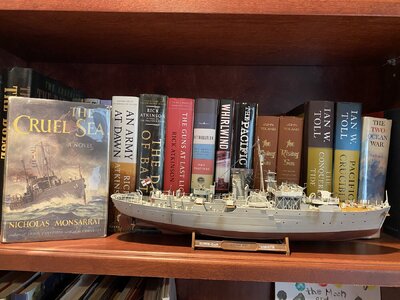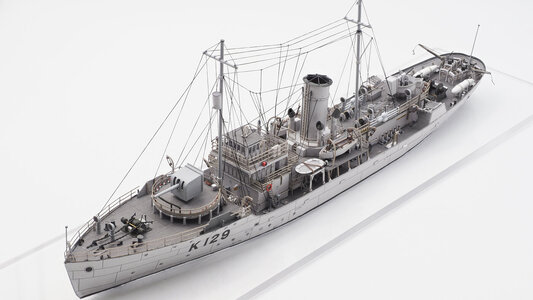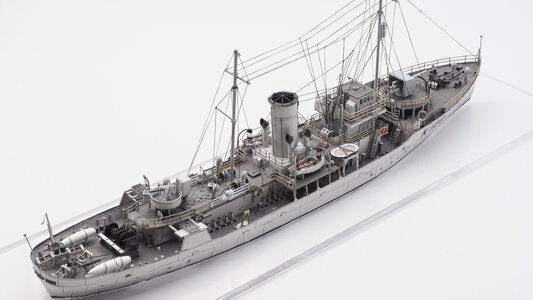This is my second build of card model, the HMV Flower Class HMCS Corvette Agassiz in 1:250 scale.
I hope you like it.
Best
Ioannis
From Wikipedia, the free encyclopedia
HMCS Agassiz was a Flower-class corvette of the Royal Canadian Navy. Named after the community of Agassiz, British Columbia, the ship was constructed by Burrard Dry Dock Co. Ltd. in North Vancouver, British Columbia and was launched on 15 August 1940. The corvette was commissioned on 23 January 1941 in Vancouver, British Columbia. The Flower class were initially designed for coastal service during the Second World War, but due to the demands of the Battle of the Atlantic, Agassiz was used primarily as an ocean escort for convoys crossing the Atlantic Ocean in engagements with German submarines. Following the war, the corvette was sold for scrapFlower-class corvettes like Agassiz serving with the Royal Canadian Navy during the Second World War were different from earlier and more traditional sail-driven corvettes.
The Flower-class corvettes originated from a need that arose in 1938 to expand the Royal Navy following the Munich Crisis. A design request went out for a small escort for coastal convoys.Based on a traditional whaler-type design, the initial Canadian ships of the Flower class had a standard displacement of 950 long tons (970 t). They were 205 feet 1 inch (62.51 m) long overall with a beam of 33 feet 1 inch (10.08 m) and a maximum draught of 13 feet 5 inches (4.09 m). The initial 1939–1940 corvettes were powered by a four-cylinder vertical triple expansion engine powered by steam from two Scotch boilers turning one three-bladed propeller rated at 2,800 indicated horsepower (2,100 kW). The Scotch boilers were replaced with water-tube boilers in later 1939–1940 and 1940–1941 Programme ships. The corvettes had a maximum speed of 16 knots (30 km/h; 18 mph). This gave them a range of 3,450 nautical miles (6,390 km; 3,970 mi) at 12 knots (22 km/h; 14 mph). The vessels were extremely wet.
The Canadian Flower-class vessels were initially armed with a Mk IX BL 4-inch (102 mm) gun forward on a CP 1 mounting and carried 100 rounds per gun. The corvettes were also armed with a QF Vickers 2-pounder (40 mm, 1.6 in) gun on a bandstand aft, two single-mounted .303 Vickers machine guns or Browning 0.5-calibre machine guns for anti-aircraft defence and two twin-mounted .303 Lewis machine guns, usually sited on bridge wings. For anti-submarine warfare, they mounted two depth charge throwers and initially carried 25 depth charges. The corvettes were designed with a Type 123 ASDIC sonar set installed. The Flower-class ships had a complement of 47 officers and ratings.The Royal Canadian Navy initially ordered 54 corvettes in 1940 and these were fitted with Mark II Oropesa minesweeping gear used for destroying contact mines. Part of the depth charge rails were made portable so the minesweeping gear could be utilised.
I hope you like it.
Best
Ioannis
From Wikipedia, the free encyclopedia
HMCS Agassiz was a Flower-class corvette of the Royal Canadian Navy. Named after the community of Agassiz, British Columbia, the ship was constructed by Burrard Dry Dock Co. Ltd. in North Vancouver, British Columbia and was launched on 15 August 1940. The corvette was commissioned on 23 January 1941 in Vancouver, British Columbia. The Flower class were initially designed for coastal service during the Second World War, but due to the demands of the Battle of the Atlantic, Agassiz was used primarily as an ocean escort for convoys crossing the Atlantic Ocean in engagements with German submarines. Following the war, the corvette was sold for scrapFlower-class corvettes like Agassiz serving with the Royal Canadian Navy during the Second World War were different from earlier and more traditional sail-driven corvettes.
The Flower-class corvettes originated from a need that arose in 1938 to expand the Royal Navy following the Munich Crisis. A design request went out for a small escort for coastal convoys.Based on a traditional whaler-type design, the initial Canadian ships of the Flower class had a standard displacement of 950 long tons (970 t). They were 205 feet 1 inch (62.51 m) long overall with a beam of 33 feet 1 inch (10.08 m) and a maximum draught of 13 feet 5 inches (4.09 m). The initial 1939–1940 corvettes were powered by a four-cylinder vertical triple expansion engine powered by steam from two Scotch boilers turning one three-bladed propeller rated at 2,800 indicated horsepower (2,100 kW). The Scotch boilers were replaced with water-tube boilers in later 1939–1940 and 1940–1941 Programme ships. The corvettes had a maximum speed of 16 knots (30 km/h; 18 mph). This gave them a range of 3,450 nautical miles (6,390 km; 3,970 mi) at 12 knots (22 km/h; 14 mph). The vessels were extremely wet.
The Canadian Flower-class vessels were initially armed with a Mk IX BL 4-inch (102 mm) gun forward on a CP 1 mounting and carried 100 rounds per gun. The corvettes were also armed with a QF Vickers 2-pounder (40 mm, 1.6 in) gun on a bandstand aft, two single-mounted .303 Vickers machine guns or Browning 0.5-calibre machine guns for anti-aircraft defence and two twin-mounted .303 Lewis machine guns, usually sited on bridge wings. For anti-submarine warfare, they mounted two depth charge throwers and initially carried 25 depth charges. The corvettes were designed with a Type 123 ASDIC sonar set installed. The Flower-class ships had a complement of 47 officers and ratings.The Royal Canadian Navy initially ordered 54 corvettes in 1940 and these were fitted with Mark II Oropesa minesweeping gear used for destroying contact mines. Part of the depth charge rails were made portable so the minesweeping gear could be utilised.









